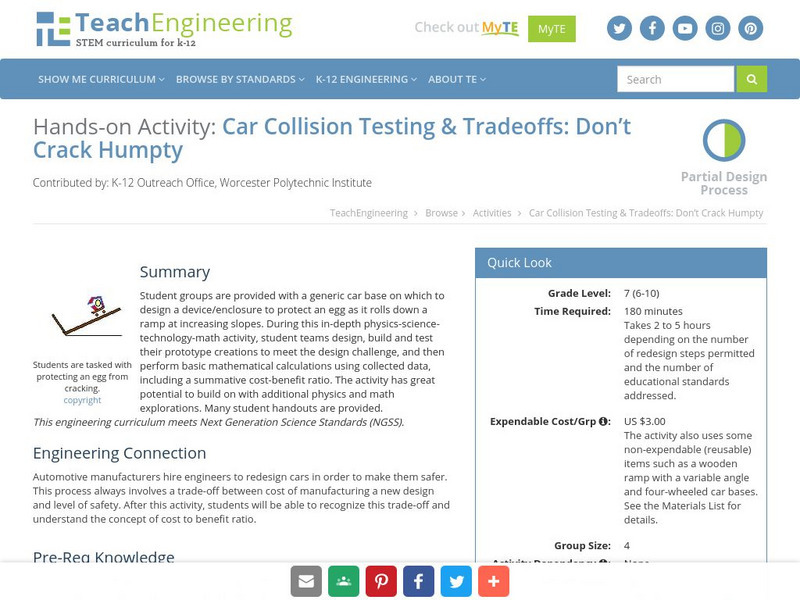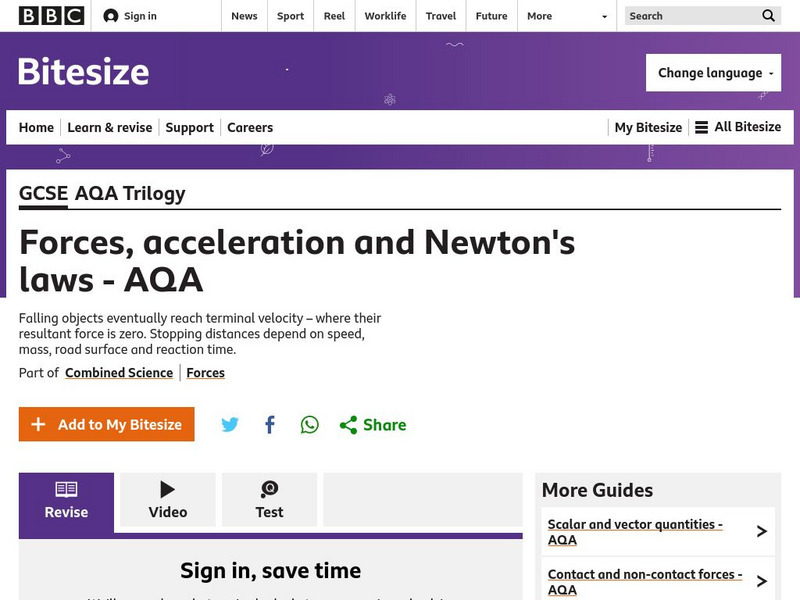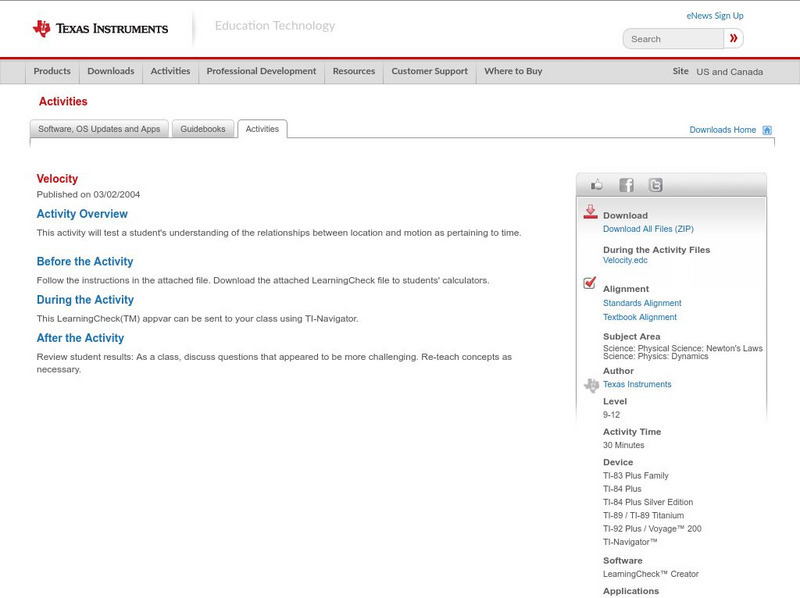CK-12 Foundation
Ck 12 Exploration Series: Simulations: Physics: Model Rocket
[Free Registration/Login Required] Learn about the relationship between position and velocity for a model rocket during launch and in free-fall. Experiment with rocket mass, rocket thrust, and rocket burn time to understand the...
CK-12 Foundation
Ck 12 Exploration Series: Simulations: Physics: Stow Lake
[Free Registration/Login Required] Learn about the patterns of wave interference in water in this simulation.
TeachEngineering
Teach Engineering: Car Collision Testing & Tradeoffs: Don't Crack Humpty
Student groups are provided with a generic car base on which to design a device/enclosure to protect an egg as it rolls down a ramp at increasing slopes. During this activity, student teams design, build and test their prototype...
Texas Instruments
Texas Instruments: Shape Up!
In this activity, students can use the motion detector to record motion, and observe how the direction of movement, speed of travel, and the rate of change of direction and speed affect the shape of a distance-time plot.
Texas Instruments
Texas Instruments: Vernier a Speedy Slide With Easy Data App and Cbr 2
Students can use a CBR 2 motion detector to determine their speed or velocity going down a playground slide. They will also experiment with different ways to increase their speed going down the slide.
Science Struck
Science Struck: Kinetic Energy Formula
Explains what is meant by kinetic energy and demonstrates how to use the formulas for a point mass moving at less than the speed of light, for rotational motion, and for a mass moving at a relativistic speed. Includes interactive...
Texas Instruments
Texas Instruments: Match Me!
In this activity, students move in a specific way in front of the motion detector to create motion plots that match a given Distance versus Time plot. They make connections between types of movements and characteristics of Distance-Time...
Georgia State University
Georgia State University: Hyper Physics: Earth Orbit Velocity
A discussion and statement of an equation for orbital speed. An interactive JavaScript form allows the user to investigate the relationship between orbital height and orbital speed. A very good opportunity to practice and receive...
BBC
Bbc: Gcse Bitesize: Forces, Acceleration and Newton's Laws Aqa
This lesson focuses on Newton's First Law: an object remains in the same state of motion unless a resultant force acts on it. If the resultant force on an object is zero, this means: a stationary object stays stationary; a moving object...
TeachEngineering
Teach Engineering: Super Spinners!
Use this hands-on activity to demonstrate rotational inertia, rotational speed, angular momentum, and velocity. Students build at least two simple spinners to conduct experiments with different mass distributions and shapes, as they...
Physics Classroom
The Physics Classroom: Newtons Laws: Skydiving Interactive
Students explore the motion of an object falling under the influence of air resistance. Force arrows and values are shown as the object falls, and a speedometer displays the speed of the object. The mass of the falling object and the...
Physics Classroom
The Physics Classroom:einstein Theory of Special Relativity: Length Contraction
One of the peculiar aspects of Einstein's theory of special relativity is that the length of objects moving at relativistic speeds undergoes a contraction along the dimension of motion. These animations depict this phenomena of length...
Physics Aviary
Physics Aviary: Circular Acceleration
This program gives students a visual representation of why an object moving in a circle at constant speed is accelerating. This program will guide students through a method of calculating the circular acceleration based on the change in...
Physics Aviary
Physics Aviary: Circular Force Lab
This lab is designed to have students find the relationships that affect the force required to keep an object moving in a circle. Students will be able to modify the mass of the object, the speed of the object and the size of the circle...
Texas Instruments
Texas Instruments: Velocity
This activity will test a student's understanding of the relationships between location and motion as pertaining to time.
Science Education Resource Center at Carleton College
Serc: Direction of Acceleration
In this short lab, students use Tonka trucks to observe the acceleration of a object as it initiates acceleration, maintains a steady speed, and slows to a stop.
TED Talks
Ted: Ted Ed: The Fundamentals of Space Time: Part 2
In this second installment of a three-part series on space-time, CERN scientists Andrew Pontzen and Tom Whyntie use a space-time diagram to analyze the sometimes confounding motion of light. [4:50]
Physics Aviary
Physics Aviary: Practice Problems: Energy/momentum Ballistic Pendulum
Students must predict the pre-collision speed of a ball that has been captured by a ballistic pendulum.
Physics Aviary
Physics Aviary: Practice Problems: 2 D Momentum Conservation With Energy
Students must predict the KE added to the system when a Kuiper Belt Object is hit with an explosive charge. Students must first look at the momentum of each piece after the explosion to determine the original speed of the Kuiper Belt...
Physics Aviary
Physics Aviary: Practice Problems: Ice Bucket Challenge
Students must calculate the maximum and minimum speeds for a bucket whirled in a vertical circle.
Physics Aviary
Physics Aviary: Practice Problems: Ice Bucket Challenge Level 1
Students must calculate the maximum and minimum speeds for a bucket whirled in a vertical circle.
Other
Usra: Lunar and Planetary Institute: Hot Spot Activity [Pdf]
In this lesson, students will measure the distances between Hawaiian islands, and convert and graph their data to determine the speed of the Pacific Plate.
Khan Academy
Khan Academy: What Is the Maxwell Boltzmann Distribution?
In a gas, there are lots of molecules traveling at lots of different speeds. Here's a framework for thinking about that.
Science and Mathematics Initiative for Learning Enhancement (SMILE)
Smile: The Great Tin Race
This activity is a great way to show distance and time relationships while incorporating charts and graphing. Different sized tins are raced against each other, and data is collected.
Other popular searches
- Speed and Motion
- Forces and Motion Speed
- Motion Speed and Velocity
- Force Motion Friction Speed
- Motion Speed and Distance
- Motion, Speed and Distance
- Speed Velocity Motion
- Describing Motion Speed
- Motion and Speed Labs
- Slow Speed Motion
- Speed and Motion Graphs
- Motion and Speed Lessons














